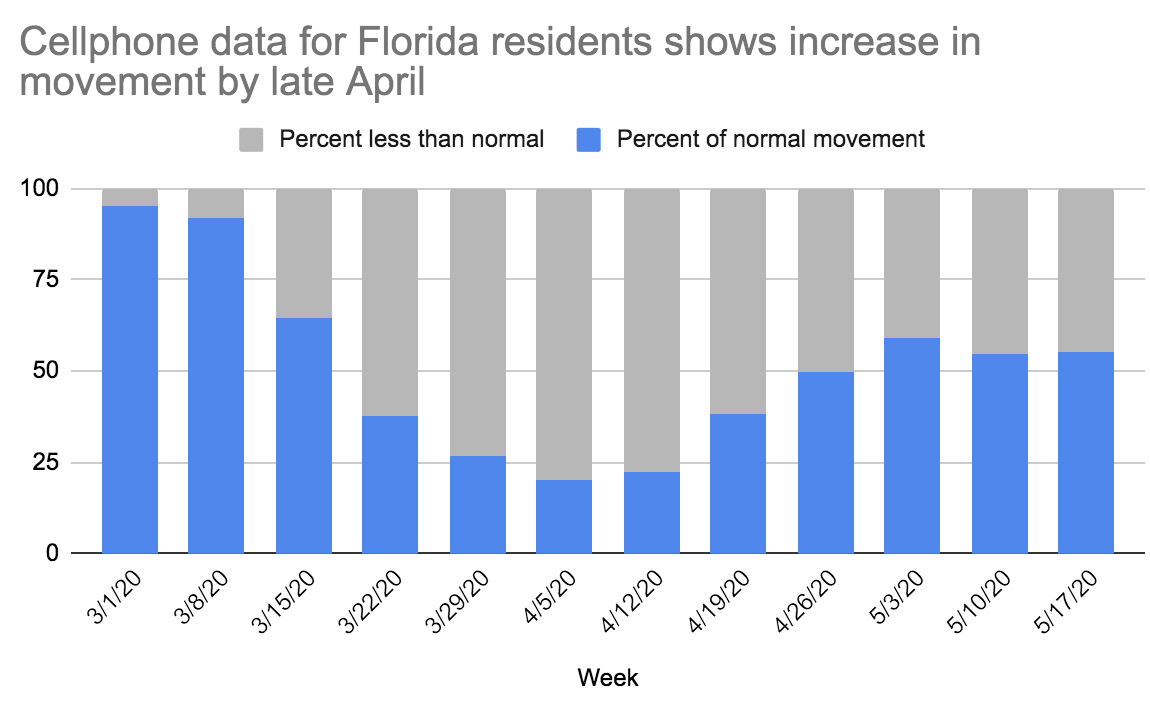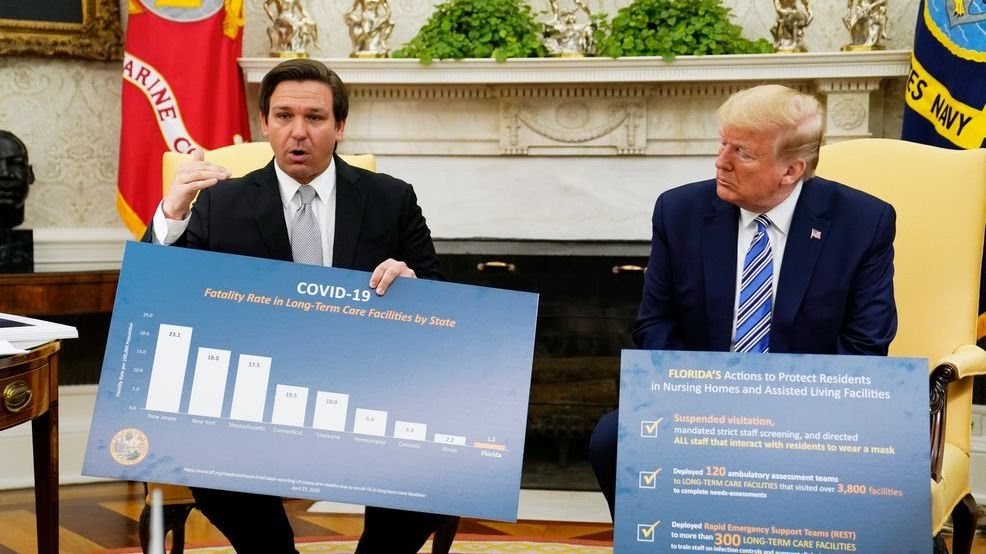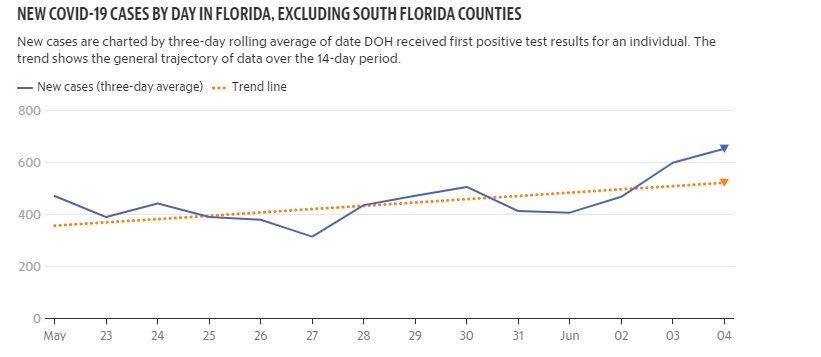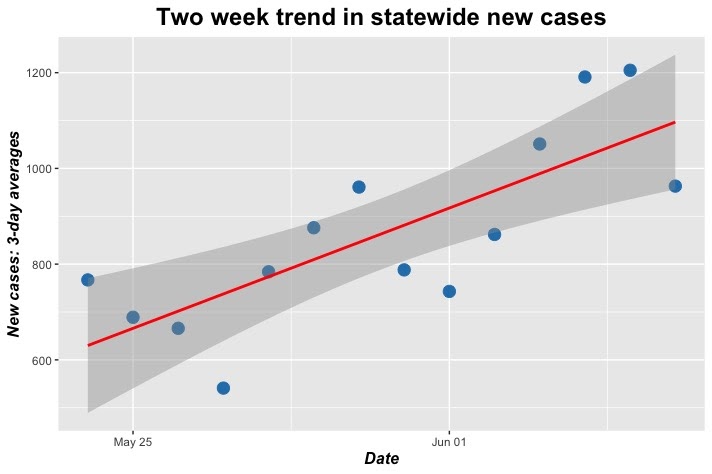In mid-April — after weeks of social distancing, quarantine living, and a rapidly rising rate of confirmed COVID-19 cases — there seemed to be a breakthrough in Florida. (THREAD)
Gov. Ron DeSantis began talking about reopening, saying the worst was over for the state.
“People were literally just frightened to the dickens,” he said on April 20, criticizing the media and public health experts for in his view exaggerating the crisis. https://hrld.us/30Ck7eO ">https://hrld.us/30Ck7eO&q...
“People were literally just frightened to the dickens,” he said on April 20, criticizing the media and public health experts for in his view exaggerating the crisis. https://hrld.us/30Ck7eO ">https://hrld.us/30Ck7eO&q...
Reported new COVID-19 cases had been steadily declining that month.
But by the time reopening began, Florida no longer appeared to be meeting federal guidelines.
But by the time reopening began, Florida no longer appeared to be meeting federal guidelines.
Cellphone mobility data show that Floridians — many of whom had been staying inside their homes — started moving around after DeSantis spoke.
In those counties set to reopen first, the decline in new cases slowed within two weeks.
Then the numbers began to rise — *before* restrictions were lifted on May 4, according to confidential state data obtained exclusively by the @MiamiHerald. https://bit.ly/2XTKfQf ">https://bit.ly/2XTKfQf&q...
Then the numbers began to rise — *before* restrictions were lifted on May 4, according to confidential state data obtained exclusively by the @MiamiHerald. https://bit.ly/2XTKfQf ">https://bit.ly/2XTKfQf&q...
Much of the state no longer appeared to be hitting the metrics it needed to meet federal guidelines for reopening, our analysis shows.
But it reopened anyway.
So, on what information did the governor base his push to reopen?
But it reopened anyway.
So, on what information did the governor base his push to reopen?
When DeSantis announced that most counties would reopen for business on May 4, he cited his administration’s “data-driven strategy” and success at achieving “critical benchmarks in flattening the curve.”
But a review of the data that DeSantis was using shows his public statements often were at odds with real-time facts. https://hrld.us/2B4Nawt ">https://hrld.us/2B4Nawt&q...
A glaring example came April 29, when DeSantis brought a slideshow to a news conference to announce that all but 3 counties would lift stay-home orders.
“The curve was flattened," he said. "The goal has been satisfied.”
Except the data painted a more troubling picture.
“The curve was flattened," he said. "The goal has been satisfied.”
Except the data painted a more troubling picture.
At the time the governor spoke, the state, excluding South Florida, was on the third day of a four-day rise in its positivity rate, according to confidential Department of Health data obtained exclusively and analyzed by the @MiamiHerald.
Still, it’s onward to Phase 2.
Last week, on June 5, DeSantis announced that most counties could start allowing groups of 50 or more people to gather at bars and clubs.
Last week, on June 5, DeSantis announced that most counties could start allowing groups of 50 or more people to gather at bars and clubs.
The next day, Florida reported one of its highest daily spikes in confirmed positive COVID-19 cases since the state began providing updates on the coronavirus in March.
A closer look at the state’s data shows that new cases have been rising over the last month in a way that can’t be explained by increased testing alone.
Yesterday, Florida saw 1,698 new known cases, the highest single-day total of confirmed cases yet. https://hrld.us/2UAlYww ">https://hrld.us/2UAlYww&q...
Yesterday, Florida saw 1,698 new known cases, the highest single-day total of confirmed cases yet. https://hrld.us/2UAlYww ">https://hrld.us/2UAlYww&q...
But when DeSantis made the Phase 2 announcement at Universal Studios in Orlando, he again pointed to charts and graphs that showed the virus slowing in Florida.
As he did when he announced Phase 1, his office has refused to make public the data he used to prepare them.
As he did when he announced Phase 1, his office has refused to make public the data he used to prepare them.
It’s been an ongoing battle over information.
While DeSantis’ administration has boasted of its transparency, records on COVID-19 at nursing homes and prisons were released only after intense pressure and threatened lawsuits.
And it was incomplete. https://hrld.us/3flcHAK ">https://hrld.us/3flcHAK&q...
While DeSantis’ administration has boasted of its transparency, records on COVID-19 at nursing homes and prisons were released only after intense pressure and threatened lawsuits.
And it was incomplete. https://hrld.us/3flcHAK ">https://hrld.us/3flcHAK&q...
Among other discrepancies, state data on COVID-19 deaths also don’t match those provided by medical examiners, who count all deaths in Florida, regardless of whether the deceased is a resident of the state.
This matters, public health experts say, because trust in data is what helps people comply with government guidelines during a crisis.
“It’s difficult to get the compliance of the population if they don’t believe what they’re being told or if they are getting different versions,’’ said Lawrence Marcus, codirector of the National Preparedness Leadership Initiative at the Harvard T.H. Chan School of Public Health.
“If there’s discrepancies in the numbers, if there are controversies about who is a COVID fatality and who’s not, that only foments confusion.’’
As Floridians venture out, key information, like the number of people currently sick with the virus, isn& #39;t available.
Floridians also don’t have data on backlogs from private labs, which analyze 90 percent of tests.
All this helps to distort the reality, health experts say.
Floridians also don’t have data on backlogs from private labs, which analyze 90 percent of tests.
All this helps to distort the reality, health experts say.
That’s why data journalists @Tallbrighty and @Blaskey_S and reporters @NickNehamas, @MaryEllenKlas, @dchangmiami and @conarck took a deep dive into the numbers, painting a fuller picture of the coronavirus’ spread in Florida.
Because someone has to.
Because someone has to.
Reporting the stories that matter to our community takes a lot of work, time and, yes, money.
To support our journalism, please consider a digital subscription today: https://bit.ly/3hffaya ">https://bit.ly/3hffaya&q...
To support our journalism, please consider a digital subscription today: https://bit.ly/3hffaya ">https://bit.ly/3hffaya&q...

 Read on Twitter
Read on Twitter







